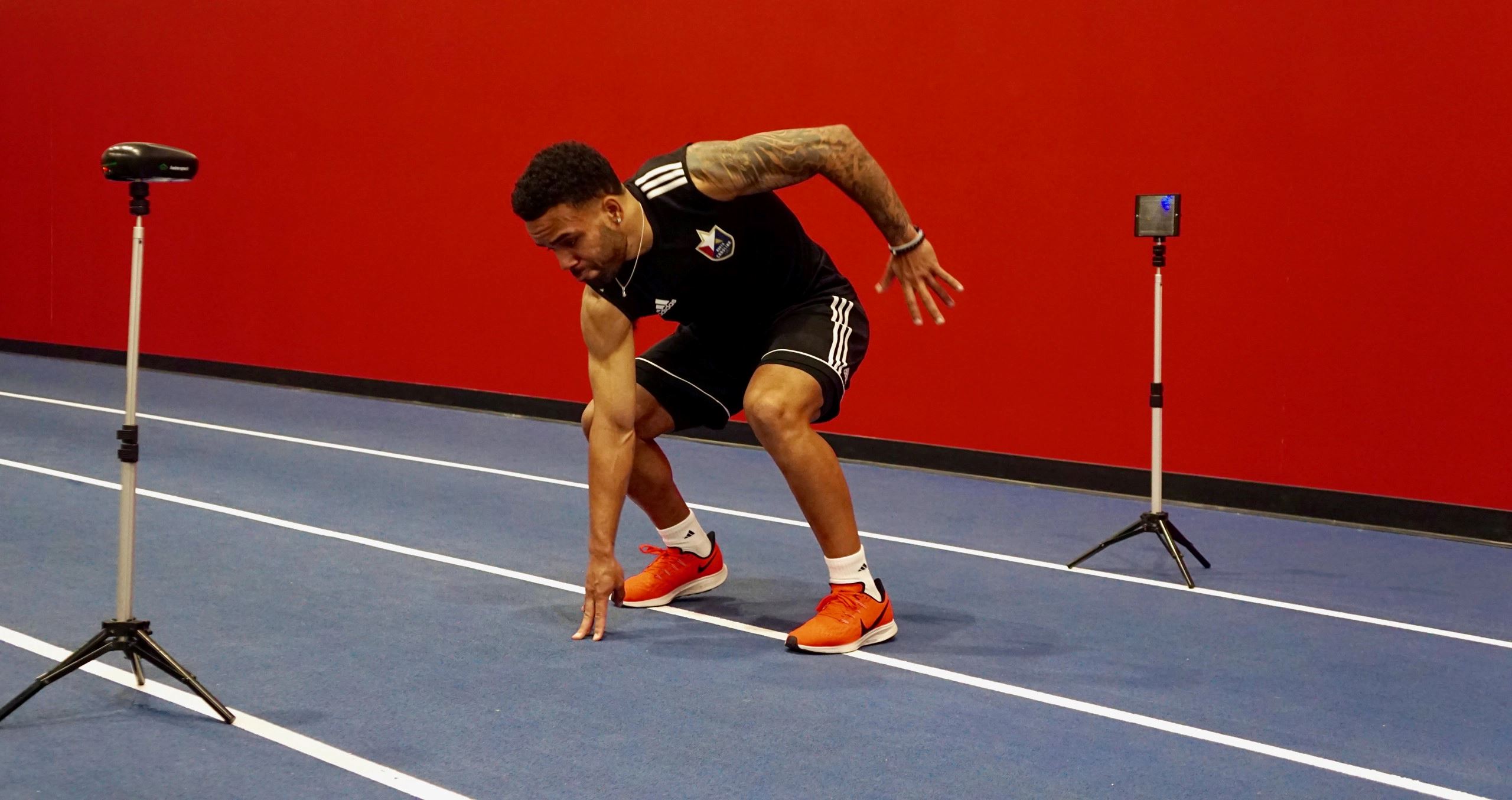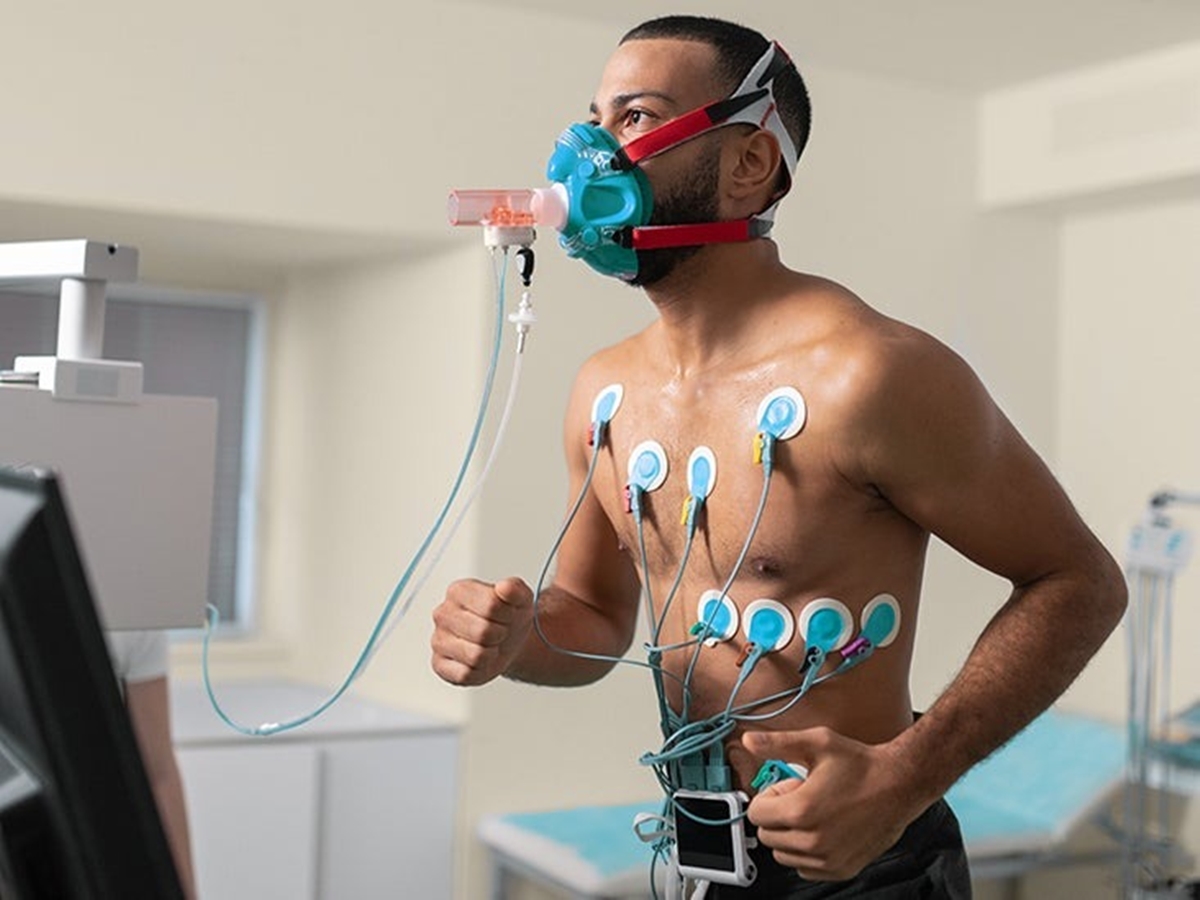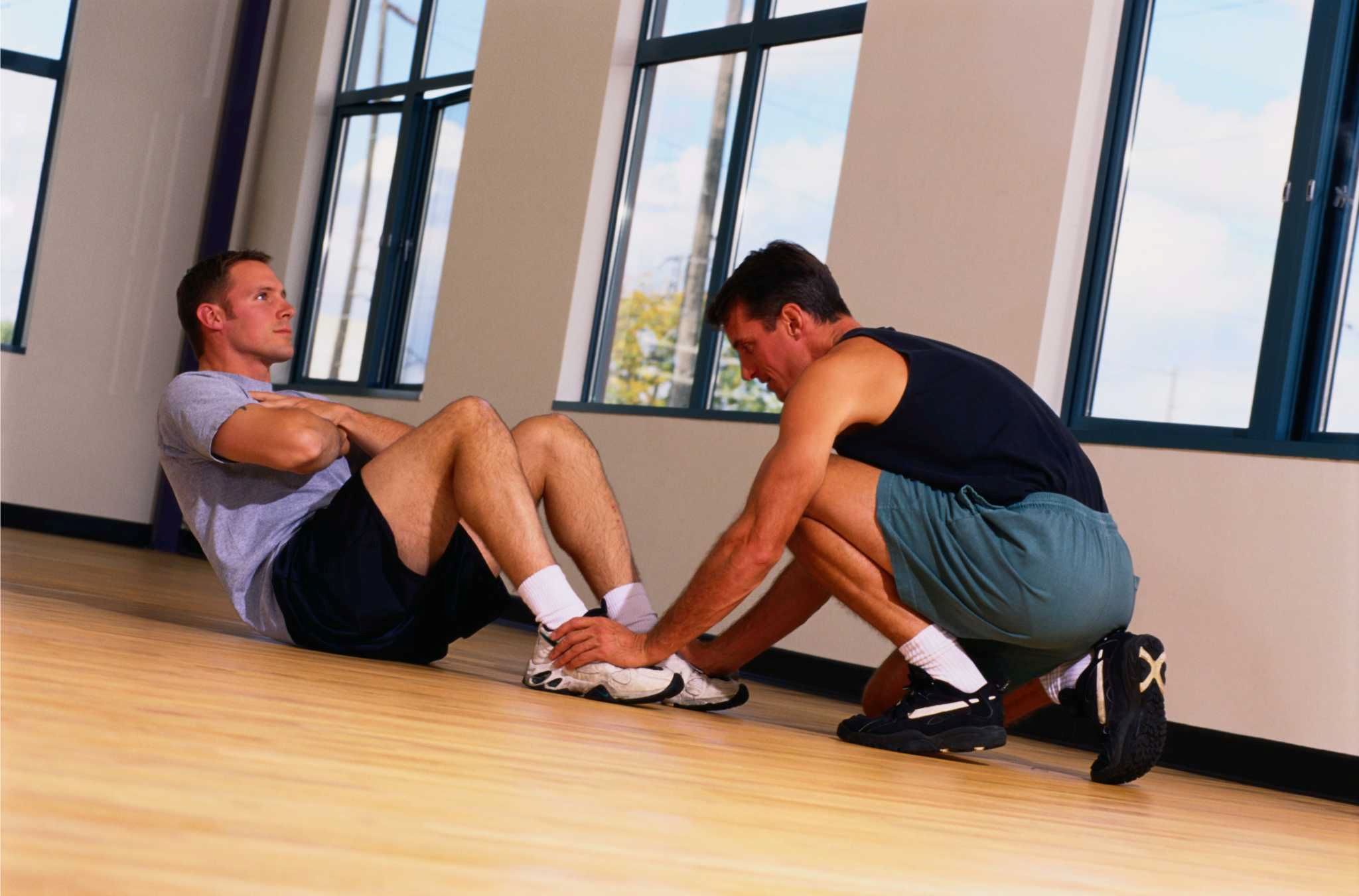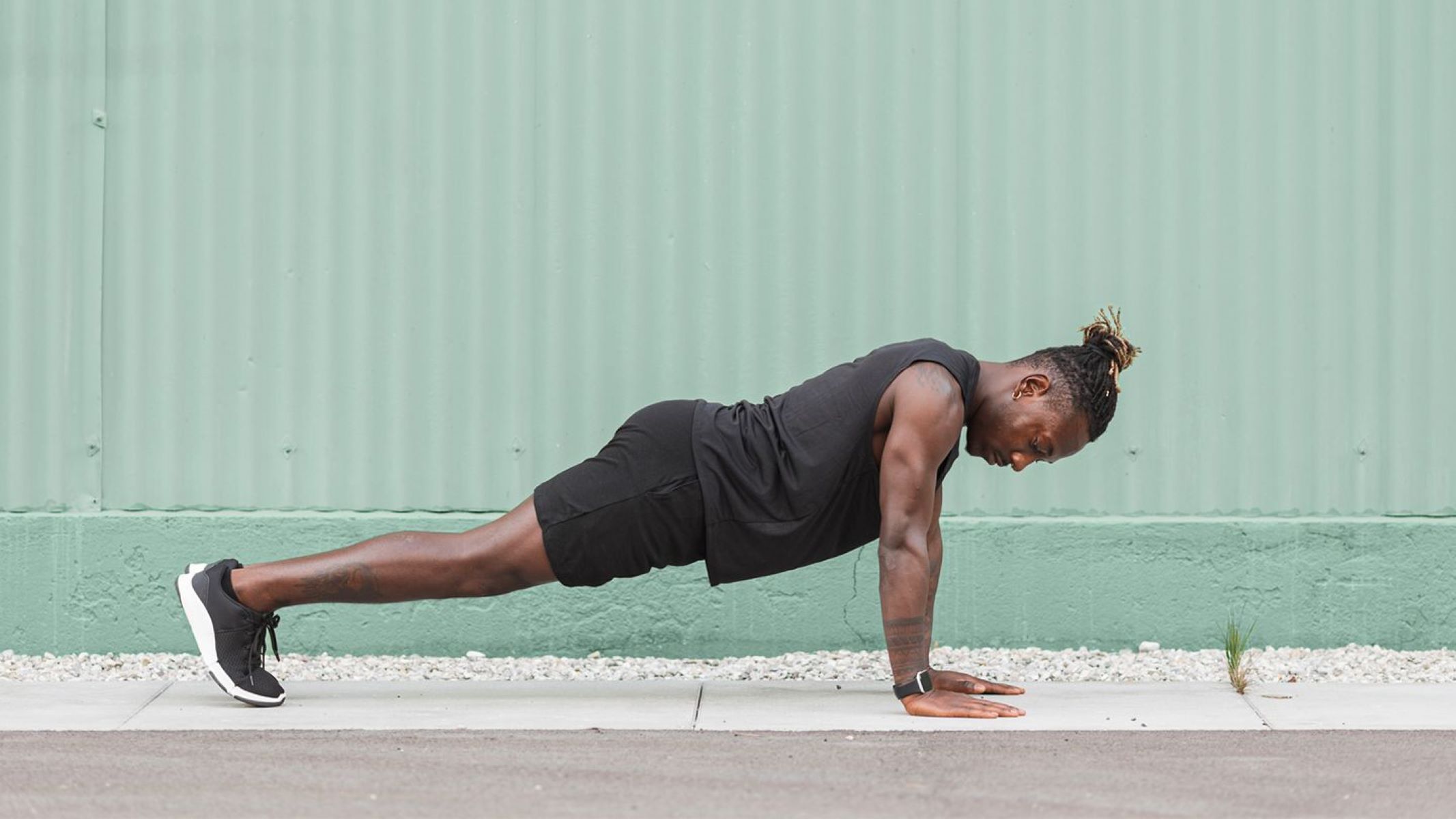

Featured
How To Test Athletic Performance
Modified: January 22, 2024
Discover the ultimate guide on how to test athletic performance, with a focus on featured techniques. Enhance your training and reach new levels of athleticism.
Introduction
Athletic performance testing plays a crucial role in evaluating the physical abilities and skills of athletes. Whether they are professional athletes seeking to improve their performance or individuals looking to assess their fitness levels, testing provides valuable insights and data. These tests enable athletes and coaches to identify strengths and weaknesses, set goals, and design effective training programs to enhance overall performance.
Testing athletic performance is not limited to competitive sports alone. It also applies to fitness enthusiasts who want to track their progress, establish benchmarks, and measure improvements in various physical attributes. From speed and agility to power and endurance, these tests provide a comprehensive assessment of an individual’s athletic abilities.
In this article, we will explore the importance of athletic performance testing and delve into the various types of tests used to evaluate different aspects of physical fitness. We will also discuss the process of conducting these tests, including safety considerations and methods for recording and analyzing results. Additionally, we will examine how the interpretation of test results can influence training programs and overall performance.
While athletic performance testing is a systematic and scientific process, it goes beyond mere numbers and measurements. It is an art as well as a science, requiring expertise and experience to obtain accurate and meaningful results. By understanding the principles and methodologies behind these tests, athletes and coaches can make informed decisions and take the necessary steps to reach their full potential.
Importance of Testing Athletic Performance
Athletic performance testing serves as a valuable tool for athletes, coaches, and fitness enthusiasts alike. It provides numerous benefits that contribute to overall performance enhancement and optimal physical fitness. Here are some key reasons why testing athletic performance is important:
- Evaluation of Current Fitness Levels: Testing allows individuals to assess their current fitness levels and identify areas for improvement. By understanding their strengths and weaknesses, athletes can focus on specific aspects of their training to achieve balanced and well-rounded athleticism.
- Goal Setting: Performance testing provides athletes and coaches with the ability to set realistic and measurable goals. By establishing benchmarks based on test results, athletes are better equipped to track progress and strive for continuous improvement.
- Monitoring Progress: Regular performance testing enables athletes to monitor their progress over time. It provides tangible evidence of improvements and allows for adjustments in training programs to maximize performance gains.
- Identification of Weaknesses: Testing reveals specific areas of weakness that may be hindering an athlete’s performance. Whether it’s lack of speed, limited endurance, or poor agility, identifying these weaknesses allows athletes to address them through targeted training and conditioning.
- Optimization of Training: By understanding an athlete’s individual strengths and weaknesses through testing, coaches and trainers can develop customized training programs. These programs are tailored to address specific areas that need improvement, leading to more effective and efficient training.
- Selection and Talent Identification: Testing is often used in the selection process for elite sports teams and talent identification programs. It provides an objective and standardized assessment to identify athletes with potential and the necessary physical attributes for specific sports.
- Injury Prevention: Performance tests can also identify imbalances, muscle weaknesses, or movement dysfunctions that may increase the risk of injury. By pinpointing these issues, athletes can take proactive measures to address them and reduce the likelihood of injuries.
- Motivation and Confidence Building: Performance testing can serve as a motivational tool for athletes. Seeing improvements in test results can boost confidence, provide validation for hard work, and inspire athletes to continue pushing their limits.
Overall, testing athletic performance provides a comprehensive understanding of an individual’s physical abilities and helps optimize training programs for maximum performance gains. By leveraging the insights gained from testing, athletes and coaches can work towards achieving their goals and unlocking their full athletic potential.
Types of Athletic Performance Tests
Athletic performance tests encompass a wide range of assessments that evaluate different aspects of an individual’s physical abilities. These tests provide valuable information about an athlete’s strengths, weaknesses, and overall athletic potential. Here are some common types of athletic performance tests:
- Physical Fitness Tests: These tests assess general fitness components such as cardiovascular endurance, muscular strength, flexibility, and body composition. Examples include the 1.5-mile run, push-up test, sit and reach test, and body fat measurements.
- Speed and Agility Tests: Speed and agility tests measure an athlete’s ability to move quickly and change direction efficiently. The 40-yard dash, shuttle run, and ladder drills are commonly used to evaluate speed, acceleration, agility, and coordination.
- Power and Strength Tests: These tests focus on an athlete’s explosive power and muscular strength. Tests such as the vertical jump, standing long jump, bench press, and squat assess an athlete’s ability to generate force and power in specific muscle groups.
- Endurance Tests: Endurance tests evaluate an athlete’s ability to sustain physical activity over a prolonged period. The Cooper Test, beep test, and the 3,000-meter run are examples of tests that measure aerobic endurance and stamina.
- Skill Tests: Skill tests assess an athlete’s proficiency in specific sports skills. These tests can include shooting accuracy in basketball, dribbling speed in soccer, or serve accuracy in tennis. They provide insight into an athlete’s sport-specific abilities and technique.
- Agility and Coordination Tests: Agility and coordination tests evaluate an athlete’s ability to quickly change direction, maintain balance, and perform precise movements. The T-test, shuttle run, and balance tests are commonly used to assess these attributes.
- Anaerobic Capacity Tests: These tests measure an athlete’s ability to perform high-intensity exercises for short durations. Tests like the Wingate Anaerobic Test and the 300-yard shuttle run assess an individual’s anaerobic power and capacity.
- Reaction Time Tests: Reaction time tests evaluate an athlete’s ability to react quickly to a stimulus. They assess the speed and accuracy of an athlete’s response, which is crucial in sports that require quick decision-making and reflexes.
- Flexibility Tests: Flexibility tests measure an athlete’s range of motion around specific joints. Examples include the sit and reach test, shoulder flexibility test, and hip mobility assessments. Flexibility is important for injury prevention and optimal athletic performance.
It’s important to note that these are just a few examples, and there are numerous other specific tests and variations used in different sports and fitness programs. Athletic performance tests should be selected based on the specific goals, requirements, and demands of the sport or activity being assessed.
By conducting a variety of performance tests, athletes and coaches can gain a comprehensive understanding of an athlete’s strengths and areas for improvement. This data is invaluable in developing targeted training programs to enhance overall athletic performance.
Physical Fitness Tests
Physical fitness tests are an essential component of athletic performance assessment. These tests evaluate an individual’s overall fitness level by measuring various components such as cardiovascular endurance, muscular strength, flexibility, and body composition. Here are some common physical fitness tests:
- 1.5-Mile Run: This test measures cardiovascular endurance. Participants are required to complete a 1.5-mile run as quickly as possible. The test assesses the efficiency of the cardiovascular system and provides an indication of aerobic fitness.
- Push-Up Test: The push-up test measures upper body strength and muscular endurance. Participants perform as many push-ups as possible in a set period. It evaluates the strength and endurance of the chest, shoulders, and triceps muscles.
- Sit and Reach Test: The sit and reach test assesses flexibility, particularly in the lower back and hamstring muscles. Participants sit on the floor with legs extended and reach toward their toes. The distance reached determines the level of flexibility.
- Body Composition Measurements: Body composition tests determine the percentage of body fat and lean body mass. Methods such as skinfold calipers, bioelectrical impedance, and dual-energy X-ray absorptiometry (DEXA) may be used for accurate measurements.
- Burpee Test: The burpee test is a full-body exercise that measures muscular endurance and cardiovascular fitness. Participants perform a sequence of exercises involving a squat, burpee, and vertical jump. The goal is to complete as many repetitions as possible within a set time.
- Plank Test: The plank test evaluates core and abdominal strength and endurance. Participants hold a plank position, supporting the body with forearms and toes, for as long as possible. It assesses the stability and strength of the core muscles.
- Vertical Jump Test: The vertical jump test measures lower body power and explosiveness. Participants jump vertically as high as possible, and the height reached is measured. It provides an assessment of leg strength and power.
- Grip Strength Test: The grip strength test evaluates hand and forearm strength. Participants use a dynamometer to measure the maximum force they can exert while squeezing the device. It is an indicator of overall upper body strength and can be useful in certain sports and physical activities.
These physical fitness tests provide valuable information about an individual’s overall fitness level, identifying areas of strength as well as areas that may need improvement. By conducting these tests, athletes and fitness enthusiasts can set baseline measurements, track progress, and design targeted training programs to enhance their physical fitness.
It’s important to note that fitness tests should be administered by qualified professionals to ensure accuracy and safety. Proper warm-up and cool-down protocols should be followed, and participants should be encouraged to perform to the best of their abilities. Regular testing intervals can provide insights into an individual’s progress and help motivate continued improvement in fitness levels.
Speed and Agility Tests
Speed and agility are essential components of athletic performance in many sports. Speed refers to how quickly an athlete can cover a distance, while agility involves the ability to change direction, accelerate, decelerate, and react quickly. Speed and agility tests aim to assess an individual’s ability in these areas. Here are some common speed and agility tests:
- 40-Yard Dash: The 40-yard dash is a classic test of speed used across various sports. Participants sprint a distance of 40 yards (approximately 36.6 meters) as quickly as possible. This test measures acceleration, top speed, and overall sprinting ability.
- Shuttle Run: The shuttle run, also known as the 5-10-5 drill, evaluates an athlete’s agility, lateral quickness, and change of direction abilities. Participants sprint 5 yards to one side, touch the line, sprint 10 yards to the opposite side, touch the line again, and then sprint back to the starting point.
- Ladder Drills: Ladder drills are a series of footwork exercises performed within a ladder-shaped grid drawn on the ground. These drills improve foot speed, coordination, and agility. Examples of ladder drills include the two-in-two-out drill, lateral shuffle, and high knees.
- Illinois Agility Test: The Illinois Agility Test measures an athlete’s speed, agility, and quickness. Participants navigate a series of cones arranged in a specific pattern, performing forward sprints, lateral movements, and quick changes of direction.
- Pro-Agility Test (5-10-5 Test): Similar to the shuttle run, the pro-agility test assesses an athlete’s ability to quickly change direction. Participants start in a three-point stance and sprint 5 yards to one side, touch the line, sprint 10 yards to the opposite side, touch the line, and finish by sprinting 5 yards back to the starting point.
- Hexagon Test: The hexagon test is a multi-directional agility test. Participants stand inside a hexagon-shaped grid and move quickly between each corner, following the designated sequence. It evaluates an athlete’s ability to change direction rapidly and maintain balance.
- T-Test: The T-test is a widely used agility test that measures an athlete’s ability to change direction quickly. Participants start at the base of a T-shaped course and perform a series of sprints, forward and lateral movements, and quick direction changes.
- Four Square Drill: The four square drill is a challenging agility exercise that incorporates forward and lateral movements. Participants move through a series of four squares, following a specific pattern of movements that require quick changes in direction and acceleration.
These speed and agility tests provide valuable insights into an athlete’s ability to move quickly, react swiftly, and change direction efficiently. They are often used in sports such as soccer, basketball, football, and tennis, where speed, agility, and quickness are crucial for success.
It’s important to conduct these tests on a suitable surface to minimize the risk of injury. Proper warm-up and dynamic stretching exercises should be performed beforehand. Coaches and trainers should provide clear instructions and ensure that participants maintain proper form and technique throughout the tests.
By regularly assessing an athlete’s speed and agility using these tests, coaches and trainers can identify areas for improvement and tailor training programs to enhance these critical components of athletic performance.
Power and Strength Tests
Power and strength are fundamental attributes that significantly impact athletic performance across various sports. Power refers to the ability to exert maximum force in the shortest amount of time, while strength refers to the capacity to produce force. Power and strength tests evaluate an individual’s ability in these areas. Here are some common power and strength tests:
- Vertical Jump Test: The vertical jump test measures an athlete’s explosive leg power. Participants jump vertically as high as possible, and the height reached is measured. This test assesses lower body strength and power, which are essential for activities such as basketball, volleyball, and track and field.
- Bench Press: The bench press is a popular test of upper body strength. Participants lie on a bench and lift a barbell loaded with weights. The maximum weight lifted successfully in a controlled manner indicates upper body strength, particularly in the chest, shoulders, and triceps muscles.
- Squat Test: The squat test evaluates lower body strength. Participants perform a squat exercise with a barbell on their shoulders, bending their knees and lowering their hips until the thighs are parallel to the ground. This test measures the strength of the quadriceps, hamstrings, and gluteal muscles.
- Medicine Ball Throw: The medicine ball throw measures upper body power and strength. Participants throw a weighted medicine ball as far as possible, using explosive movements from the chest or overhead. This test assesses the power generated by the upper body and core muscles.
- Deadlift: The deadlift is a compound exercise that assesses overall strength, particularly in the lower back, hips, and legs. Participants lift a loaded barbell from the ground, standing up with the weight. This test evaluates the ability to generate force through the posterior chain muscles.
- Handgrip Dynamometer Test: The handgrip dynamometer test evaluates hand and forearm strength. Participants squeeze a handheld dynamometer, and the maximum force exerted is measured. Grip strength is crucial in activities such as rock climbing, wrestling, and golf.
- Single-Leg Hop Test: The single-leg hop test assesses strength and power in the lower body, specifically in the quadriceps and calf muscles. Participants hop on one leg while maintaining balance, and the distance covered is measured. This test is often used in sports that require explosive power, such as skiing and basketball.
- Leg Press: The leg press test measures lower body strength, focusing on the quadriceps, hamstrings, and gluteal muscles. Participants push against a weighted sled with their legs, moving it away from their body. The maximum weight lifted successfully indicates lower body strength.
These power and strength tests provide valuable insights into an individual’s ability to generate force and power in specific muscle groups. They are often used in strength and conditioning programs, as well as in sports that require explosive movements or physical confrontations.
Proper warm-up and technique demonstrations are essential to ensure safety and accuracy during these tests. Participants should perform a proper warm-up, including dynamic stretching, to prepare the muscles and joints. Coaches and trainers should provide guidance and monitor participants to ensure proper form and technique execution.
By regularly assessing an athlete’s power and strength using these tests, coaches and trainers can track progress, identify muscular imbalances, and design targeted training programs to enhance overall athletic performance.
Endurance Tests
Endurance is a crucial component of athletic performance, especially in sports that require sustained physical exertion or prolonged aerobic activity. Endurance tests evaluate an individual’s ability to maintain physical activity over an extended period. These tests provide valuable insights into an athlete’s cardiovascular fitness, stamina, and aerobic capacity. Here are some common endurance tests:
- Cooper Test: The Cooper test is a widely used assessment of aerobic endurance. Participants run as far as they can within a set time (typically 12 minutes). The distance covered indicates the level of cardiovascular fitness and endurance.
- Beep Test: The beep test, also known as the Yo-Yo test, is a progressive shuttle run that assesses aerobic endurance and maximal oxygen uptake (VO2 max). Participants run back and forth between two points, timed to an audio signal that progressively gets faster. The test continues until exhaustion.
- 3,000-Meter Run: The 3,000-meter run evaluates an athlete’s endurance and aerobic capacity. Participants run 3,000 meters (approximately 1.86 miles) as quickly as possible. This test provides insight into an individual’s stamina and ability to sustain a moderate to high-intensity effort over a longer distance.
- Marathon Simulation: The marathon simulation test emulates the demands of a marathon. Participants run a predetermined distance, typically 20 to 26.2 miles (32 to 42.2 kilometers), in a controlled setting. This test assesses an athlete’s ability to maintain a consistent pace and endure physically and mentally over a long-distance race.
- Step Test: The step test evaluates cardiovascular fitness and endurance. Participants step onto and off a step or bench at a set pace for a predetermined duration. Heart rate recovery is monitored after the exercise to assess cardiovascular fitness.
- Swim Test: The swim test evaluates endurance and cardiovascular fitness in the water. Participants swim a set distance, such as 1,000 meters or more, at a consistent pace. This test is often used in triathlons or swimming competitions.
- Cycle Ergometer Test: The cycle ergometer test assesses endurance and cardiovascular fitness using a stationary bike. Participants cycle at a specified workload or for a set duration while monitoring heart rate, power output, or other relevant indicators.
- Rowing Test: The rowing test measures endurance and cardiovascular capacity using a rowing machine. Participants row for a specific distance or duration, maintaining a consistent effort level. This test is commonly used in rowing competitions or as part of overall endurance assessment.
It’s crucial to design and conduct endurance tests based on the specific requirements and demands of the sport or activity being assessed. Proper warm-up, hydration, and pacing strategies should be followed to ensure accurate and safe results. Qualified professionals should monitor participants during the tests to provide guidance and ensure proper technique.
By regularly assessing an athlete’s endurance using these tests, coaches and trainers can track improvements, detect areas that need attention, and design training programs to enhance overall aerobic capacity and stamina.
Skill Tests
In addition to physical attributes such as strength and endurance, skill tests are also essential for evaluating an athlete’s proficiency in specific sports skills. Skill tests provide insights into an individual’s technique, accuracy, and level of mastery in executing sport-specific movements. These tests are crucial for identifying strengths and weaknesses and determining areas that require improvement. Here are some common skill tests:
- Shooting Accuracy: Shooting accuracy tests assess an athlete’s precision in shooting a ball or projectile at a target. This test is commonly used in sports such as basketball, soccer, hockey, and archery.
- Dribbling Speed and Control: Dribbling tests evaluate an athlete’s ability to manipulate a ball while maintaining control and speed. These tests are commonly used in sports such as basketball, soccer, field hockey, and lacrosse.
- Serve Accuracy: Serve accuracy tests are commonly used in sports such as tennis, badminton, and volleyball. These tests assess an athlete’s ability to place the ball accurately in specific target areas while serving.
- Passing Accuracy: Passing accuracy tests evaluate an athlete’s ability to deliver accurate and precise passes to teammates or targets. This test is commonly used in team sports such as soccer, basketball, and rugby.
- Catching and Hand-Eye Coordination: Catching tests assess an athlete’s hand-eye coordination, reaction time, and ability to make successful catches. These tests are commonly used in sports such as baseball, cricket, football, and ultimate frisbee.
- Balance and Stability: Balance tests evaluate an athlete’s ability to maintain stability and control while executing specific movements. These tests are particularly important in sports such as gymnastics, figure skating, snowboarding, and surfing.
- Tackling and Defensive Skills: Tackling and defensive skill tests assess an athlete’s ability to execute proper tackling techniques and defensive maneuvers. These tests are commonly used in contact sports such as football, rugby, and martial arts.
- Shot Accuracy: Shot accuracy tests measure an athlete’s ability to hit a target with precision. These tests are frequently used in sports such as basketball, hockey, soccer, and golf.
- Reaction Time: Reaction time tests evaluate an athlete’s ability to respond quickly to a stimulus. These tests are commonly used in sports that require quick decision-making and reflexes, such as tennis, boxing, martial arts, and baseball.
Skill tests are designed to measure an athlete’s technical abilities and are specific to the requirements and nuances of each sport. Coaches, trainers, and evaluators must carefully observe and assess an athlete’s performance during these tests, providing feedback to help hone their skills and improve overall proficiency.
Regular skill testing allows athletes to identify areas for improvement and track progress over time. By focusing on specific skills, athletes can design targeted training programs to enhance their abilities and ultimately elevate their performance in their respective sports.
Conducting Athletic Performance Tests
Conducting athletic performance tests requires careful planning, organization, and attention to detail to ensure accurate and meaningful results. Here is a step-by-step guide to conducting athletic performance tests:
- Set Clear Objectives: Determine the purpose of the tests and establish clear goals. Identify the specific aspects of performance to be assessed and the desired outcomes from the testing process.
- Select Appropriate Tests: Choose tests that align with the objectives and goals of the assessment. Consider the specific demands of the sport or activity, and select tests that provide valuable insights into the relevant physical attributes and skills.
- Prepare the Testing Environment: Ensure the testing environment is safe, clean, and suitable for the selected tests. Set up and organize any necessary equipment, marking the required distances and securing testing areas to minimize potential hazards.
- Explain the Testing Process: Brief participants on the purpose and procedure of each test, ensuring they understand the instructions and expectations. Clarify any specific rules, techniques, or safety precautions related to each test.
- Administer a Proper Warm-up: Conduct a structured warm-up routine to prepare participants physically and mentally for the tests. Include dynamic stretches and exercises that target the relevant muscle groups and movements.
- Ensure Consistent Testing Conditions: Maintain consistent testing conditions across all participants and testing sessions. Factors such as temperature, humidity, and equipment setup should be consistent to minimize variables that could affect test results.
- Monitor and Record Results: Document participants’ performance accurately and consistently. Use standardized forms or digital tools to record test results, including the specific measurements, times, distances, or scores achieved by each participant.
- Provide Feedback and Evaluation: Share test results with participants and provide constructive feedback, identifying strengths and areas for improvement. Tailor feedback to each individual, highlighting specific actions or training strategies that can enhance performance based on the test outcomes.
- Use Test Results for Training Program Design: Apply the insights gained from test results to develop personalized training programs. Design workouts and training sessions that target the identified weaknesses and capitalize on the individual’s strengths to optimize overall athletic performance.
- Regularly Reassess: Schedule regular reassessments to track progress over time. Repeating performance tests at specific intervals allows for the monitoring of improvements, the modification of training programs, and the evaluation of the effectiveness of interventions.
It’s important to remember that athletic performance tests should be conducted by trained professionals or under their supervision to ensure the accuracy and safety of the testing process. Proper communication, encouragement, and motivation should be provided to participants throughout the testing procedure.
By following these guidelines, coaches, trainers, and evaluators can conduct athletic performance tests in a structured and effective manner, obtaining valuable data to enhance individualized training programs and support athletes in reaching their fullest potential.
Preparation for Testing
Effective preparation is key to ensuring accurate and meaningful athletic performance testing. By taking the time to plan and prepare properly, coaches, trainers, and athletes can optimize the testing process and maximize the value of the results. Here are some important factors to consider when preparing for athletic performance testing:
- Define Testing Objectives: Clearly define the objectives of the testing process. Determine what specific physical attributes, skills, or performance metrics will be assessed and establish the goals for the testing session(s).
- Select Appropriate Tests: Carefully choose the tests that align with the objectives and goals of the assessment. Consider the sport or activity being evaluated and select tests that provide relevant and comprehensive insights into the specific physical components and skills required.
- Communicate with Participants: Inform participants about the purpose, process, and expectations of the testing. Clearly explain the tests that will be conducted, ensuring that participants understand the instructions and requirements for each test.
- Clear Any Doubts: Address any questions or concerns that participants may have regarding the testing. Foster open communication and create a supportive environment where participants feel comfortable seeking clarification or sharing any factors that may impact their performance.
- Establish Testing Timeline: Determine the schedule and logistics for the testing sessions. Allow sufficient time for warm-up, testing, rest between tests, and recovery as needed. Consider the availability of facilities and equipment and coordinate with participants to ensure their availability for the testing sessions.
- Ensure Equipment Readiness: Check and prepare all equipment required for the tests. Make sure that the equipment is in proper working condition, properly calibrated, and available in the required quantity for all participants. Set up equipment for each test in advance to minimize delays and ensure a smooth testing process.
- Arrange for Proper Facilities: Secure appropriate facilities that meet the specific requirements of the tests. Consider factors such as space, safety, lighting, temperature, and noise levels. Ensure that the testing environment is conducive to accurate and consistent performance by participants.
- Review Safety Measures: Prioritize the safety of participants during testing. Conduct a thorough review of safety protocols and guidelines, including warm-up exercises, proper technique demonstrations, and precautions for specific tests. Take measures to minimize the risk of injuries during the testing process.
- Prepare Data Collection Methods: Decide on the data collection methods and tools to be used during testing. Determine how the results will be recorded, whether through manual tracking, electronic devices, video analysis, or a combination of methods. Ensure that the chosen methods are efficient, accurate, and compatible with the specific tests being conducted.
- Organize Test Documentation and Communication: Establish a system for documenting and organizing test results and participant information. Prepare appropriate forms, spreadsheets, or digital platforms for recording and analyzing data. Communicate the test results promptly and clearly to participants, providing feedback and guidance based on the outcomes.
By paying careful attention to these preparatory steps, coaches, trainers, and athletes can ensure that the athletic performance testing process is well-organized, efficient, and conducive to accurate results. This preparation lays the groundwork for valuable insights, targeted training programs, and ongoing performance enhancement.
Safety Considerations
Ensuring the safety of participants is of utmost importance when conducting athletic performance tests. Prioritizing safety not only prevents injuries but also promotes trust, confidence, and overall well-being. Here are some key safety considerations to keep in mind during the testing process:
- Proper Warm-up and Cool-down: Begin each testing session with a structured warm-up routine to prepare participants’ bodies for the physical demands of testing. Include dynamic stretching exercises and movements that target the specific muscle groups involved in the tests. Similarly, conclude the testing session with a cool-down period to gradually reduce heart rate, loosen muscles, and promote recovery.
- Clear Instructions and Demonstration: Provide clear and concise instructions for each test, ensuring that participants understand the techniques, rules, and safety precautions involved. Offer visual demonstrations, when necessary, to ensure proper form and technique.
- Supervision by Trained Professionals: Have qualified professionals, such as coaches or trainers, oversee the testing sessions. These individuals should have expertise in the specific tests being conducted and be able to provide immediate assistance or guidance, if needed.
- Appropriate Equipment and Facilities: Ensure that the facilities and equipment used for testing are safe, functional, and suitable for the specific tests being conducted. Regularly inspect and maintain the equipment to prevent any potential hazards. Additionally, secure proper surfaces, such as well-maintained tracks or courts, to minimize the risk of slips, trips, or falls.
- Adherence to Age and Skill Level: Tailor the tests to the age, experience, and skill level of the participants. Avoid tests that are beyond their current abilities or may pose a higher risk of injury. Progressively increase the difficulty and intensity of tests as participants gain expertise and conditioning.
- Participant Health Screening: Prior to testing, conduct thorough health screenings for participants to identify any preexisting conditions or health concerns that may affect their performance or safety during the tests. Ensure all participants are medically cleared for the specific physical demands of the tests.
- Proper Rest and Recovery: Allow adequate rest and recovery between tests to prevent fatigue and decrease the risk of injuries. Have participants hydrate and refuel appropriately during breaks to maintain energy levels and prevent dehydration.
- Emergency Plan: Develop an emergency plan in case of any injuries or medical emergencies during the testing sessions. Ensure that all personnel involved are familiar with the plan and know how to respond promptly, including contacting medical professionals if necessary.
- Communication and Consent: Clearly communicate the nature of the tests, potential risks involved, and the voluntary nature of participation. Obtain consent from participants or their legal guardians before conducting any tests. Encourage an open line of communication for participants to report any discomfort, pain, or concerns during or after the testing.
By incorporating these safety considerations into the testing process, coaches, trainers, and evaluators can provide a secure and supportive environment for participants. Proactive safety measures not only protect individuals but also foster trust and confidence in the testing process, allowing participants to perform to the best of their abilities.
Testing Procedures
The testing procedures for athletic performance tests involve a systematic approach to ensure consistency, accuracy, and fairness in the assessment. Following standardized testing procedures allows for meaningful comparisons and reliable results. Here are the key steps involved in the testing process:
- Explain the Testing Order: Inform participants of the order in which the tests will be conducted. Providing a clear schedule helps them mentally prepare and understand the flow of the testing session.
- Collect Baseline Data: Gather essential baseline information from participants before the tests commence. This may include demographic details, previous training experience, and any relevant medical or injury history.
- Measure and Record Anthropometric Data: Obtain baseline anthropometric measurements such as height, weight, and body composition using appropriate tools and techniques. Accurate and consistent record-keeping is crucial for subsequent analysis and comparisons.
- Perform Standardized Warm-up: Conduct a structured warm-up routine for all participants to raise core body temperature, increase blood flow to muscles, and enhance overall readiness for performance. This warm-up should include dynamic stretching, cardiovascular exercises, and sport-specific movements.
- Test Familiarization: Allow participants to familiarize themselves with the specific tests by demonstrating the proper technique, providing opportunities for practice, and answering any questions they may have. Familiarization increases confidence and ensures accurate and consistent performance.
- Conduct Test Trials: Begin the testing process by administering the tests according to the predetermined order. Ensure that the participants understand the instructions and perform the tests to the best of their abilities. Encourage maximal effort, but also emphasize the importance of safety and proper technique.
- Record Test Results: Accurately document the results of each participant. Record the specific measurements, times, distances, or scores achieved in a systematic manner. Use standardized forms, spreadsheets, or digital platforms to ensure consistency and ease of analysis.
- Monitor and Encourage Rest: Provide participants with adequate rest periods between tests to prevent fatigue and ensure optimal performance. Use these intermissions to offer hydration, nutrition, and recovery strategies to maintain energy levels throughout the testing session.
- Address Safety Concerns: Continuously monitor participants for any signs of discomfort or potential injury. Intervene or adjust testing parameters as needed to prioritize their well-being. Implement safety measures to minimize the risk of accidents, such as securing equipment, maintaining clear testing areas, and providing appropriate supervision.
- Repeat Test Trials (If Required): In some cases, tests may need to be repeated to ensure accurate and reliable results. This may be necessary if there are technical issues, questionable performances, or if confirmation of initial results is needed.
- Cool-down and Recovery: Conclude the testing session with a proper cool-down period that includes low-intensity exercises and stretching. Encourage participants to engage in post-testing recovery strategies such as proper hydration, nutrition, and adequate rest to support optimal recovery.
Consistency and attention to detail are crucial throughout the testing procedures to ensure reliable and valid results. By following these steps, coaches, trainers, and evaluators can conduct athletic performance tests in a systematic and effective manner.
Recording and Analyzing Test Results
Recording and analyzing test results are essential components of the athletic performance testing process. Accurate documentation and thorough analysis of data provide valuable insights into an athlete’s strengths, weaknesses, progress, and potential areas for improvement. Here are the key steps involved in recording and analyzing test results:
- Organize and Verify Data: Ensure the recorded test results are correctly organized for each participant. Double-check the data for accuracy, including measurements, times, distances, or scores obtained during the tests.
- Standardize Units and Formats: Use standardized units and formats when recording the test results to ensure consistency and facilitate comparisons. Convert measurements, if necessary, to a common unit of measurement for clearer analysis.
- Create Individual Profiles: Maintain individual profiles or files for each participant to track their test results over time. This allows for accurate progress monitoring and the identification of trends or patterns in performance.
- Compute Performance Metrics: Calculate performance metrics and derived variables based on the recorded test results. These metrics may include average speed, power-to-weight ratio, agility index, or other relevant indicators depending on the specific tests conducted.
- Compare Results to Normative Data: Compare individual test results to established normative data for the specific population, gender, age group, or sport. Normative data provides a benchmark for evaluating performance and identifying areas where the participant may excel or need improvement.
- Identify Strengths and Weaknesses: Analyze the test results to identify the participant’s strengths and weaknesses in various performance areas. Determine areas where the participant excels or requires additional attention and development.
- Consider Relative Strengths and Weaknesses: Take into account the relationship between different performance factors. For example, assess how upper body strength compares to lower body strength or how speed correlates with agility. Consider how adjustments in training can balance relative strengths and weaknesses.
- Monitor Progress over Time: Track the participant’s progress by comparing current test results to previous ones. Look for improvements or declines in performance to gauge the effectiveness of training interventions and identify areas for further development.
- Provide Individualized Feedback: Interpret the test results and provide individualized feedback to participants. Highlight their achievements, areas for improvement, and strategies for performance enhancement. Offer specific recommendations for tailored training programs based on the analysis of their results.
- Identify Training Priorities: Use the analysis of test results to determine priority areas for training and development. Design training programs that focus on addressing weaknesses while building upon existing strengths.
- Continually Refine Testing Protocols: Continuously evaluate the testing protocols and analysis methods to refine and improve the testing process. Make adjustments based on feedback from participants, emerging research, and changes in the sport’s landscape.
Recording and analyzing test results provide valuable insights into an athlete’s performance capabilities and guide the design of effective training programs. By following these steps, coaches, trainers, and evaluators can more effectively support athletes in optimizing their athletic potential and achieving their performance goals.
Interpreting Test Results
Interpreting test results is a crucial step in the athletic performance testing process. It involves analyzing the collected data to gain insights into an athlete’s performance capabilities, strengths, weaknesses, and areas for improvement. Proper interpretation allows coaches, trainers, and evaluators to make informed decisions and design targeted training programs. Here are the key considerations when interpreting test results:
- Compare Results to Norms: Compare individual test results to established normative data for the specific population, gender, age group, or sport. This comparison provides benchmarks to determine where the athlete stands in relation to their peers and helps identify areas where they excel or may need further development.
- Identify Standout Performances: Identify test results that stand out as particularly strong or exceptional. These standout performances may indicate areas of expertise or specialized skills that can be leveraged and refined to enhance overall athletic performance.
- Assess Areas for Improvement: Identify areas where the athlete’s test results indicate room for improvement or development. These may be areas where performance falls below the normative data or where potential weaknesses are revealed. Understanding these areas helps target training interventions more effectively.
- Consider Relative Strengths and Weaknesses: Consider the interplay between different performance factors. Assess how the athlete’s strengths in one area may compensate for weaknesses in another. For example, exceptional agility may compensate for lower speed, or exceptional upper body strength may contribute to performance in certain sports or activities.
- Look for Consistency: Consider the consistency of test results over time. Look for patterns and trends in performance to determine whether improvements are consistent, stable, or temporary. This helps ensure that training programs and interventions are addressing the underlying factors leading to consistent performance gains.
- Account for Individual Factors: Consider individual factors such as injury history, training levels, and physiological characteristics when interpreting the results. Understand that each athlete is unique and may have different factors influencing their performance outcomes.
- Set Realistic and Measurable Goals: Utilize the test results to set realistic and measurable goals for the athlete. These goals should be specific, attainable, relevant, and time-bound. By setting clear objectives, athletes can work towards improving their performance in targeted areas effectively.
- Tailor Training Programs: Use the insights from test interpretation to design individualized and targeted training programs. By addressing the identified weaknesses and leveraging strengths, trainers and coaches can optimize the athlete’s performance potential and promote well-rounded development.
- Monitor Progress: Continuously monitor and track the athlete’s progress over time. Regularly retest to evaluate improvements and identify areas that may need further attention. This ongoing monitoring helps assess the effectiveness of interventions and adjust training programs accordingly.
- Provide Meaningful Feedback: Communicate the interpretation of test results to the athlete in a clear and constructive manner. Provide detailed feedback that focuses on specific areas of improvement, strategies for growth, and reinforcement of strengths. This feedback helps athletes understand their performance and motivates them to work towards their goals.
Interpreting test results is a critical part of the athletic performance testing process. By carefully analyzing the data and considering the relevant factors, coaches, trainers, and evaluators can make informed decisions to optimize an athlete’s training program and support their journey towards peak performance.
Factors Affecting Athletic Performance
Athletic performance is influenced by a wide range of factors that can affect an athlete’s ability to perform at their best. These factors encompass various aspects, including physical attributes, mental state, skill level, and external influences. Understanding these factors is crucial for optimizing performance and developing effective training strategies. Here are some key factors that can have an impact on athletic performance:
- Genetics: Genetic factors play a significant role in determining an individual’s physical attributes, such as muscle fiber type, body composition, and aerobic capacity. Genetic predispositions can influence an athlete’s potential for success in certain sports or specific skill sets.
- Physical Fitness Level: The level of physical fitness, including cardiovascular endurance, muscular strength, power, flexibility, and agility, directly influences an athlete’s performance. A high level of fitness improves an athlete’s ability to execute movements, resist fatigue, and recover quickly.
- Technical Skills: Skill level and proficiency in specific sports-related techniques and movements impact performance. Skill development, including coordination, accuracy, timing, and sport-specific tactics, prepares athletes to meet the demands of their sport effectively.
- Mental and Psychological Factors: Mental factors, such as motivation, concentration, focus, confidence, and mental toughness, significantly influence athletic performance. A strong mental game helps athletes cope with pressure, maintain composure during challenges, and utilize their physical abilities effectively.
- Nutrition and Hydration: Proper nutrition and hydration are essential for optimal athletic performance. Consuming an appropriate balance of macronutrients and micronutrients supports energy production, muscle recovery, and cognitive function. Adequate hydration is vital for body temperature regulation and maintaining optimal cognitive and physical performance.
- Rest and Recovery: Sufficient rest and recovery are vital for maximizing athletic performance. Quality sleep, proper rest intervals between training sessions, and active recovery strategies allow the body to repair, regenerate, and adapt to training stimuli. Inadequate recovery can lead to overtraining, fatigue, and increased risk of injuries.
- Training Strategies: The training program design, including the frequency, intensity, duration, and specificity of workouts, significantly affects athletic performance. Well-structured and periodized training programs promote progressive adaptation, prevent overuse injuries, and optimize physical capacities for peak performance.
- Environmental Factors: Environmental conditions, such as temperature, humidity, altitude, and weather, can impact performance. Athletes must adapt to and manage these factors during training and competition to minimize their adverse effects on endurance, hydration, and thermoregulation.
- Equipment and Technology: The quality and suitability of equipment, such as footwear, apparel, and sports gear, can impact an athlete’s performance. Additionally, advancements in sports technology, such as wearable devices, motion analysis, and performance tracking tools, provide crucial feedback and insights for optimizing training and performance.
- Coaching and Support System: The guidance, expertise, and support from coaches, trainers, and the overall support system can significantly impact an athlete’s performance. Effective coaching helps athletes set goals, plan training, refine technique, and provide motivation and support to navigate challenges and achieve their full potential.
- Competition and Competitive Environment: The level of competition and the competitive environment in which an athlete operates can influence performance. Athletes competing at higher levels or in more challenging environments may experience increased pressure and intensity, requiring mental preparation and adaptability.
It’s important to recognize the multifactorial nature of athletic performance. Considering and managing these factors appropriately allows for a comprehensive approach to improving performance and supporting athletes in reaching their goals.
Training Programs Based on Test Results
Developing training programs based on test results is a crucial step in optimizing athletic performance. Test results provide valuable insights into an athlete’s strengths, weaknesses, and areas for improvement. Tailoring training programs to address specific needs identified through testing ensures that training efforts are focused, efficient, and effective. Here are some key considerations when designing training programs based on test results:
- Identify Areas for Improvement: Analyze the test results to identify the areas where the athlete’s performance falls below expectations or where significant improvements can be made. These areas highlight the specific physical attributes or skills that require development.
- Set Specific and Measurable Goals: Based on the identified areas for improvement, establish clear and target-specific goals. Set measurable objectives that provide direction and help track progress over time. Goals should be challenging yet attainable, focusing on both short-term and long-term performance outcomes.
- Address Individual Needs: Consider the individuality of each athlete when designing training programs. Recognize differences in fitness levels, training history, skillsets, and any limitations or restrictions. Develop personalized plans that account for these individual needs to foster optimal progress.
- Implement Periodization: Incorporate periodization principles into training programs to balance training loads, progression, and recovery. Structure training phases (such as preparatory, competitive, and transition periods) to systematically address different aspects of performance and optimize adaptation to training stimuli.
- Focus on Weaknesses: Devote a significant portion of the training program to improving the identified weaknesses. Implement specific exercises, drills, or training modalities that target and challenge the areas requiring improvement. Gradually progress the difficulty and intensity of these exercises over time.
- Maximize Strengths: Capitalize on the athlete’s strengths to enhance overall performance. Integrate exercises and training methods that further develop and leverage the areas where the athlete excels. Strengthening strengths can provide a competitive advantage and compensate for weaknesses in other areas.
- Balance Training Components: Design training programs that address all relevant components for performance enhancement. Include exercises and training methods that target cardiovascular endurance, muscular strength, power, agility, flexibility, skill development, and recovery strategies.
- Incorporate Periodic Testing: Regularly reassess the athlete’s performance through periodic testing to monitor progress and adjust the training program accordingly. Use these test results as feedback to fine-tune the training variables, modify goals, and ensure continuous improvement.
- Include Functional and Sport-Specific Training: Integrate functional exercises and sport-specific drills into the training program. Emphasize movement patterns, skills, and tasks that closely mimic the demands of the athlete’s sport or activity. This type of training enhances transferability and directly improves performance on the field or court.
- Monitor and Adjust: Continuously monitor the athlete’s response to the training program and adjust the program as needed. Regularly assess progress, gauge the effectiveness of training interventions, and make modifications based on observed outcomes and athlete feedback.
- Supportive Coaching and Guidance: Provide ongoing coaching, guidance, and support to athletes throughout the training program. Offer motivation, feedback, and technical input to optimize performance and maintain athlete morale and commitment.
Designing training programs based on test results allows coaches, trainers, and athletes to target specific areas for improvement and maximize overall athletic potential. By employing these principles, athletes can progress systematically and efficiently toward their performance goals.
Conclusion
Athletic performance testing is a vital tool for evaluating an athlete’s physical abilities, identifying strengths and weaknesses, and designing targeted training programs. By conducting a variety of tests, including physical fitness assessments, speed and agility tests, power and strength evaluations, endurance tests, and skill assessments, coaches, trainers, and athletes gain valuable insights into performance capabilities.
Through proper preparation, clear communication, and adherence to safety considerations, athletic performance tests can be conducted effectively. By recording and analyzing test results, coaches and trainers can interpret the data to identify areas requiring improvement and capitalize on strengths.
The data from performance tests is essential for designing individualized training programs based on the specific needs and goals of the athlete. Tailoring training to address weaknesses, leverage strengths, and focus on sport-specific components facilitates growth, optimization, and peak performance.
Regular retesting allows for progress monitoring, adjustments to training programs, and ongoing refinement of an athlete’s skills and abilities. By continually adapting and refining training strategies, coaches and trainers can ensure athletes remain on a trajectory towards optimal performance.
Ultimately, athletic performance testing serves as a foundation for maximizing an athlete’s potential. When used in conjunction with expert coaching, guidance, and support, these tests provide valuable information that helps athletes build upon their strengths, overcome their weaknesses, and achieve their performance goals.









